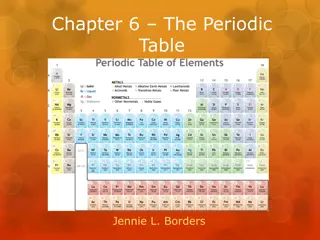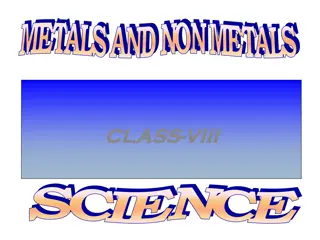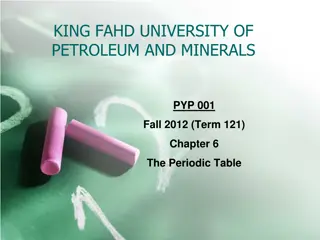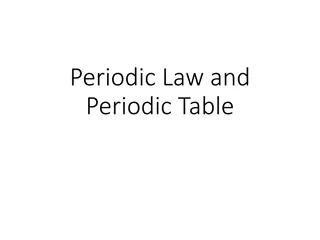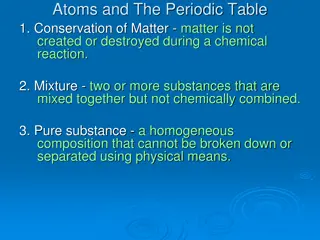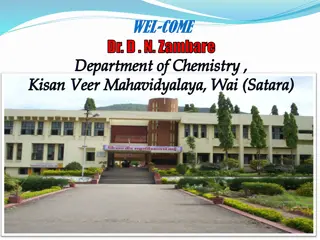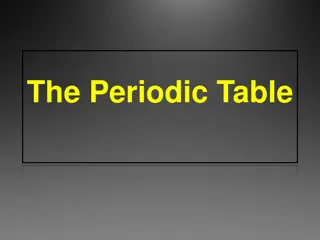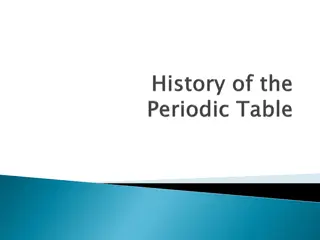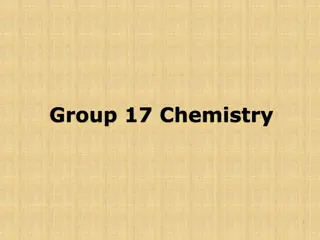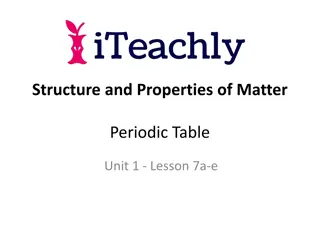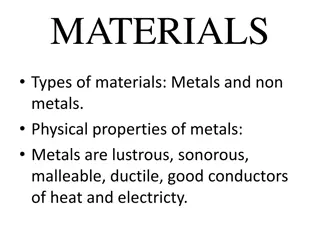Understanding Metals, Nonmetals, and Metalloids in the Periodic Table
Explore the characteristics and physical properties of metals, nonmetals, and metalloids. Learn about the differences in appearance, conductive abilities, malleability, ductility, and other key features of these elements. Discover why metals are excellent conductors of heat and electricity, while nonmetals exhibit a range of states from solids to gases. Gain insights into the fascinating world of elements in the periodic table.
Uploaded on Aug 01, 2024 | 0 Views
Download Presentation

Please find below an Image/Link to download the presentation.
The content on the website is provided AS IS for your information and personal use only. It may not be sold, licensed, or shared on other websites without obtaining consent from the author. Download presentation by click this link. If you encounter any issues during the download, it is possible that the publisher has removed the file from their server.
E N D
Presentation Transcript
Metals, Nonmetals and Metalloids
Notice the difference between the appearance of the metals and nonmetals. Click here for a better view of each of the elements.
Physical properties of METALS Metals are SOLIDS. (except mercury) Metals are HARD. (except Lithium, Potassium, Sodium)
Physical Properties of METALS Metals have shiny luster. (or metallic luster) LUSTER the way an object s surface reflects light
When you leave a spoon in a cup of hot drink, the bit poking out of the drink gets hot. Why? Conduction! METALS are the best conductors of heat. This is because the electrons in metals move more freely than in non-metals, allowing the heat energy to travel across the metal. For example, when the spoon touches the hot drink, the heat from the drink excites the electrons in the metal, and the electrons transfer the energy from one electron to another, carrying the heat all the way up the spoon quickly. Best conductors: silver and copper
Physical Properties of METALS Metals are good conductors of electricity. Copper, silver, and gold are good electrical conductors. In a conductor, electric current can flow freely. Since metals have free electrons, they can carry a charge easily. Copper Wiring
Physical Properties of METALS Metals are malleable. Malleable or Malleability - metals ability to be shaped or formed as by hammering or pressure; can be beaten into thin sheets Aluminum is malleable.
Physical Properties of METALS Metals are ductile. Ductility or ductile can be drawn into a wire
Examples of NONMETALS Non metals may be solids, liquids or gases. Examples: Solids Carbon, Sulfur, Phosphorus Liquid Bromine Gases Oxygen, Hydrogen, Nitrogen
Physical Properties of NONMETALS Nonmetals have a dull luster. (They are not shiny!) Example: Phosphorus
Physical Properties of NONMETALS Nonmetals are insulators. They do not conduct electricity or heat well. The atoms in nonmetals do not have loose electrons. Therefore, when electricity, or something hot touches a non-metal, the energy does not move quickly through the material. What would you rather stir a hot pot with a wooden spoon or a metal spoon?
Physical Properties of NONMETALS Nonmetals are soft (except for diamonds and brittle. Example: Sulfur
An interesting element: Carbon Ever break the point of your pencil? That s because it s made of graphite, a substance made up completely of Carbon a brittle nonmetal. Carbon atoms in graphite However diamonds, the hardest material of all, are made of the same element: Carbon. Look at how the carbon atoms are arranged in diamonds why do you think diamonds are harder than graphite?
METALLOIDS The elements contained in the classification of Metalloids:
METALLOIDS Elements classified as Metalloids have physical properties of both metals and non-metals. Some are shiny, some are dull, they are somewhat malleable and ductile, and can conduct heat and electricity at a lesser level than metals. SILICON ARSENIC BORON
METALLOIDS Some metalloids are useful semiconductors, which are used in electronics (radio, computers, telephones, etc.) They are useful because they conduct just the right amount of electricity or heat.
Where do we find METALS? Some metals like gold, silver, and platinum are found as pure substances in the earth s crust because they are least reactive. Most metals are reactive and are found as oxides (react with oxygen), carbonates (react with carbon), sulfides (react with sulfur). Minerals : are elements or compounds which occur naturally inside the earth s crust. Ore : is a mineral from which metals can be extracted profitably.




